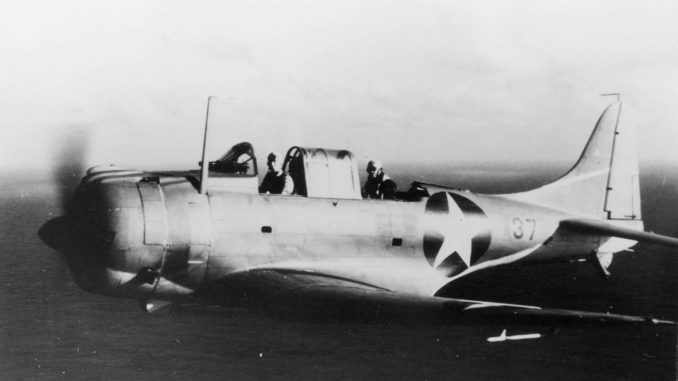
The American dive bomber force launched with the torpedo bombers, but each of the three squadrons involved took paths to the target the diverged greatly from the torpedo squadrons, and from each other. The contingent of Enterprise SBDs was led by LtCdr C. Wade McClusky, who had been promoted to air group commander a few months before. A fighter pilot by trade, McClusky was not very familiar with the SBD and had never dropped a bomb from one but he was nevertheless highly regarded. The Enterprise air leader took his men aloft at 0700, but the SBDs quickly became separated both from their fighter escort and from their torpedo squadron colleagues far below. Heading south-west, the crews settled in for the flight whilst waiting for more news of the Japanese force.
During the flight, some of Enterprise’s SBD pilots could make out the smoke rising from Midway following the Japanese attack. At 0920 the Enterprise SBDs arrived at the anticipated interception point, with Midway itself almost visible off their left wing, but there was no sign of the enemy. With no further contact reports forthcoming, either from Midway-based PBYs or from the other carrier squadrons, and lacking the fuel to conduct an ‘expanding square’ search, McClusky faced a choice to either assume that the Japanese had closed on Midway and turn left to follow, or to assume that Nagumo had made less progress than anticipated and instead turn right, in the hopes that they were still a way off. With time very much the essence and the success of the attack in his hands, making the correct choice was critical. McClusky decided to continue onwards for another 35 miles before making a right turn that was completed around 0950.
Just a few minutes later McClusky spotted what he identified as a ‘cruiser’ heading north at high speed. This was actually the destroyer Arashi, which had left the Japanese formation to make a depth charge attack on the submarine Nautilus and was now hurrying back to rejoin Nagumo and the rest of Kido Butai. The American bombers changed course to follow Arashi in the hopes of finding the elusive carriers, and 10 minutes later saw smoke on the horizon – the American bombers had at last found the Japanese force. Two SBDs dropped out of formation, probably due to fuel starvation, but the remaining 31 Enterprise Dauntlesses headed in unencumbered by Japanese fighters.
Enterprise’s VB-6 and VS-6 attack
Almost immediately, McClusky’s inexperience in his new position told – either he didn’t know or in the heat of the moment forgot US dive-bomber doctrine, which dictated how two squadrons would split their attack to hit multiple targets simultaneously. The commander of VB-6, Lt. Richard H. Best, assumed that he would attack the starboard of two carriers that were in sight as per doctrine, whilst VS-6 under LtCdr Earl Gallaher was to take the one to port. Instead, McClusky excitedly ordered Gallaher to follow him in a dive on the starboard ship in violation of doctrine. Best was just about to start his run when McClusky and Gallaher, followed by the rest of VS-6, hurtled past on their way to attack what turned out to be the Kaga. Best had the presence of mind to change his plans and lead his two wingmen to attack the ship to starboard – Nagumo’s flagship, Akagi.
At 1020, the attack began. None of the Japanese ships was equipped with radar and so it fell to Japanese lookouts to spot the high-flying aircraft, which they did as the first SBDs tipped over into their dives. Kaga and Akagi immediately put their helms over and went into emergency turns. With their Zeros still at low altitude, low on fuel and ammunition following the torpedo attack, the carriers depended on their own anti-aircraft weapons and their manoeuvrability to escape the incoming strike. Although several American pilots claimed that the carrier’s decks were packed with aircraft, in fact only a few fighters remained topside.
VS-6 led the way with their attack on Kaga. Streaming down, Gallaher’s men released bomb after bomb on the ship starting just two minutes after the attack had been detected, leaving almost no reaction time. The first three 500lb bombs dropped by the SBDs missed, but the fourth, dropped by Gallaher himself, landed on the flight deck aft and exploded with telling effect. This hit was soon followed by two more which landed near Kaga’s forward elevator, and at least one penetrated through to the hangar deck below. A fuel truck parked on the flight deck exploded and burning fuel and debris killed everyone on the bridge, leaving the ship leaderless. A fourth bomb landed amidships and added to the fires that were already raging out of control. Fires began raging out of control throughout the ship, far beyond the capabilities of Kaga’s damage control parties to contain.
Lt Best led three divisions of SBDs from VB-6 in the attack on the Akagi, but he freed his second and third divisions for independent attacks and led his own first division with 5 bombers down to Nagumo’s flagship. It appears that Best and his wingmen managed a near miss and one hit close to the amidships elevator – the latter proving to be the fatal stroke. The bomb penetrated the flight deck and exploded on the hangar deck below, which was crowded with aircraft refuelling and re-arming following the Midway strike. Very quickly a fire began to rage that was beyond the capabilities of Akagi’s crew to extinguish, a situation not helped by the fact that many of them had been killed in the explosions or blown overboard. The blast had also destroyed the ship’s radio room and several antennae, making communication with the rest of the fleet impossible. A near miss had also damaged her rudder. Before long, the ship was unable to steer and the engines had to be stopped, leaving Akagi dead in the water.
The Enterprise fliers did not escape from this attack unscathed. Initiating a high-speed, low altitude withdrawal, the SBDs had to run the gauntlet of Japanese fighters and anti-aircraft fire to make good their escape. One VS-6 SBD was hit by flak during the dive and crashed soon after pull-out with neither of the crew surviving. Levelling out after delivering their bombs, many of the remaining planes ran into Zero fighters, still at low level following the earlier torpedo attack. Another VS-6 SBD was not heard from again following the attack, and five other aircraft likewise failed to return after being shot down in the minutes after Kido Butai was hit – only two crews were rescued, leaving six unaccounted for. Only eight out of the 15 VS-6 Dauntlesses that left the Enterprise made it back to home plate.
VB-6 was hit even harder. Two of the five aircraft from Best’s own 1st Division were lost, with one crew rescued and the other captured by the Japanese. The latter crew were later executed by the crew of the cruiser Nagara. Of the 2nd division, only one aircraft made it back to the Enterprise, the other four making water landings with only two of the crews recovered. Similarly, only one SBD from the 3rd division made it home, with two of the crews rescued. In all, only five SBDs from VB-6 returned safely back to base, with no less than 10 lost during the attack. In total, the Enterprise lost 17 SBDs from her two squadrons, in addition to the losses suffered by VT-6 earlier in the morning. However, the Enterprise men had sold their lives dearly, with two of the Japanese carriers crippled.
Yorktown’s VB-3 attack
As Enterprise’s VS-6 and VB-6 were beginning their attacks, a third Dauntless squadron arrived near the Japanese carriers – Yorktown’s VB-3, led by LtCdr Maxwell Leslie. Although Yorktown had launched her strike an hour after Enterprise, her squadrons took a more direct course to Kido Butai and by sheer happenstance arrived within minutes of their colleagues. VB-3 had also kept fairly close company with VT-3 and their fighter escort, although there was no direct fighter escort for the SBDs. The Yorktown air group was, therefore, the only one of the three carrier groups to make a coordinated attack. Disaster had almost befallen Leslie’s men when they set the electrical release on their bomb racks – a fault with these had led to four pilots accidentally jettisoning their 1,000lb bombs, including Leslie himself. Each of the four chose to continue.
By taking a more direct course for the Kido Butai than the Enterprise air group had, the Yorktown men had a much shorter flight before they sighted enemy ships at 1200 – almost the same time as the Enterprise SBDs themselves saw Nagumo’s fleet. By sheer luck the Americans had contrived to get two attack groups over the Japanese fleet simultaneously, and from completely different directions. Whilst VT-3 bored in at low altitude, supported by a handful of VF-3 fighters, VB-3’s 17 SBDs remained high.
Leslie initiated an attack what he thought was the Akagi, but was actually Sōryū, the most north-eastern of the four flattops. The CO himself led the way, despite not having a bomb – he attempted to use his machine guns to strafe the Sōryū in order to give them men diving behind a slightly easier task, but his guns soon jammed and he was forced to withdraw alone. It fell to the 13 SBDs still carrying bombs to deliver the third devastating attack of the morning.
The first bomb scored a direct hit right on the enormous rising sun emblem painted on Sōryū’s flight deck. Several more SBDs delivered their attacks without scoring before a second 1,000lb bomb landed amidships and penetrated to the second hangar deck, followed by a third father aft near the number three elevator. All three bombs penetrated to the hangar deck, which like that of the Kaga and Akagi was packed with aircraft being re-armed. Fires began to take hold almost along the entire length of the ship and the conflagration was quickly out of control and beyond the ability of the ship’s damage control party to contain. Only 30 minutes later the order went out from Captain Ryusaku Yanagimoto for all hands to abandon ship.
In contrast to the two Enterprise squadrons, VB-3 escaped relatively unscathed. No SBDs were shot down near the Japanese fleet and only two of the Dauntlesses, one of them Leslie’s, were lost after they were forced to ditch near the Yorktown due to fuel starvation.
A Battle Won?
The reasons why the American attack was so effective have been debated in the years since Midway. The dive bombers were presented with a clear run to their objectives because the Japanese fighter screen was well out of position following several hours of attacks, both by Midway-based torpedo and dive-bombers and the three carrier-based torpedo squadrons. These attacks had pulled Japanese fighters all over the sky, leaving many low on fuel and ammunition, and too low to effectively intercept the SBDs before they began their deadly dives. In addition, Kido Butai lacked radar, a deficiency which had proved problematic at Coral Sea and deadly at Midway – lacking the early warning of the type that was available to American carriers thanks to their CXAM radars, the Japanese flattops were naked to surprise air attack. The nearest Japanese radar set, a Type 21, was installed on the battleship Ise which was operating with the Aleutians force, many hundreds of miles from Kido Butai.
In the space of five minutes of attacks, three Japanese carriers crippled beyond hope of repair far from home. His flagship smashed, Nagumo had to decide whether to remain aboard or to shift his flag to another vessel and continue the fight. He still had the Hiryū, which had manoeuvred away from the other carriers to avoid VT-3’s torpedo attack and had escaped the attention of the American dive bombers. Eventually, Nagumo chose to board the cruiser Nagara and make it his flagship before leading the rest of his fleet towards the Americans, although the futility of this plan soon became evident.


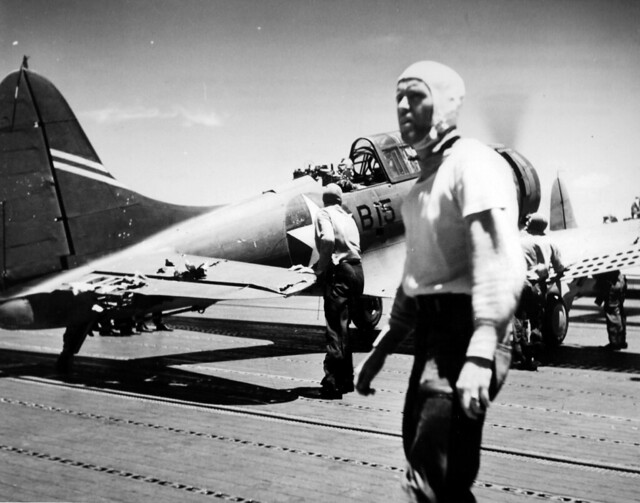
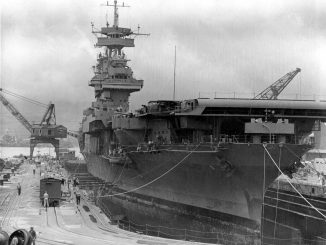
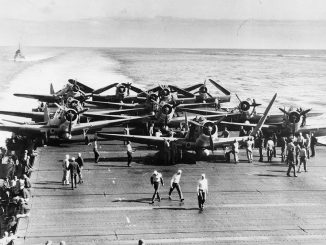
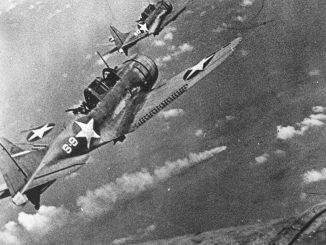
Leave a Reply